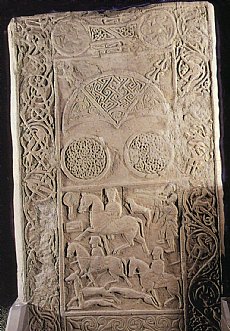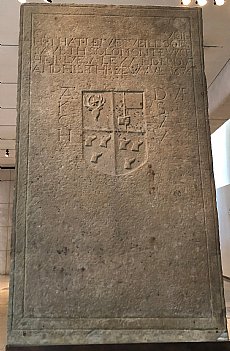Hilton of Cadboll Pictish Cross Slab
01 February 2021
- News Type:
- Find of the Month
 The Hilton of Cadboll Pictish cross slab (MHG8546) is one of the finest Pictish carved stones from Scotland. Its story resonates on many levels – as a historical source for the time, as a study of reaction against its iconography in the 17th century, a graphic example of how even large objects can be moved, a subject for experimental archaeology, and as a focal point for community memories and oral tradition.
The Hilton of Cadboll Pictish cross slab (MHG8546) is one of the finest Pictish carved stones from Scotland. Its story resonates on many levels – as a historical source for the time, as a study of reaction against its iconography in the 17th century, a graphic example of how even large objects can be moved, a subject for experimental archaeology, and as a focal point for community memories and oral tradition.
The stone was carved from a large locally-sourced sandstone block c. AD 800, measuring 2.3m high and 1.4m wide, and weighing almost 2 tonnes. Four large cross slabs on the Seaboard peninsula, Easter Ross, at Nigg (MHG7496), Shadwick (MHG8539), Hilton and Portmahomack were probably commissioned by the monastery at Portmahomack, perhaps as perimeter markers (Carver et al 2016, 246-256). Only one face, the non-cross side, survives today, but has a rich array of interlace, Pictish symbols and a hunting scene in which the central figure wears an elaborate brooch similar to some high status surviving Pictish examples.
 The cross slab was probably erected near St Mary’s Chapel in Hilton, which excavations have shown was probably active in the Pictish period, and also in Medieval times (James et al 2008). The stone had fallen at least once, and by the 17th century had snapped, leaving the base buried. At some point before 1676 the decoration on the cross side was chipped away, and the stone recarved with an inscription to Alexander Duff and his three wives. Although the most extreme case of reuse, it is not alone, with Pictish stones from Golspie (MHG10890) and Conon Bridge (MHG60000) also reworked to become 17th century gravemarkers. The stone remained at or near the chapel, with the carvings face down, until the mid 19th century. By 1903 the stone had been removed to Invergordon Castle, and in 1921 Captain MacLeod of Cadboll donated it to the British Museum. It arrived there, but was soon sent back north due to local protests, but to the National Museum of Antiquities in Edinburgh not the Highlands (James et al 2008, 238ff). It is a wonder than little damage appears to have occurred in all these moves.
The cross slab was probably erected near St Mary’s Chapel in Hilton, which excavations have shown was probably active in the Pictish period, and also in Medieval times (James et al 2008). The stone had fallen at least once, and by the 17th century had snapped, leaving the base buried. At some point before 1676 the decoration on the cross side was chipped away, and the stone recarved with an inscription to Alexander Duff and his three wives. Although the most extreme case of reuse, it is not alone, with Pictish stones from Golspie (MHG10890) and Conon Bridge (MHG60000) also reworked to become 17th century gravemarkers. The stone remained at or near the chapel, with the carvings face down, until the mid 19th century. By 1903 the stone had been removed to Invergordon Castle, and in 1921 Captain MacLeod of Cadboll donated it to the British Museum. It arrived there, but was soon sent back north due to local protests, but to the National Museum of Antiquities in Edinburgh not the Highlands (James et al 2008, 238ff). It is a wonder than little damage appears to have occurred in all these moves.
 Many local people felt the stone should be in its original location. In the 1990s a local project commissioned local sculptor Barry Grove to carve a full size replica, providing an opportunity to gain some insights into carving practices of the time. The carving was undertaken in a shed in nearby Balintore, and proved a popular draw for local and other visitors.
Many local people felt the stone should be in its original location. In the 1990s a local project commissioned local sculptor Barry Grove to carve a full size replica, providing an opportunity to gain some insights into carving practices of the time. The carving was undertaken in a shed in nearby Balintore, and proved a popular draw for local and other visitors.
The erection of the replica led to activity on the site, including an excavation of the original position of the site. This yielded numerous fragments from the cross side but also the insitu base. Barry Grove later also carved a speculative cross side incorporating some of the many fragments discovered in the excavation. Although the excavation finds are legally in the care of the National Museums of Scotland, the base was claimed by the local community and put on display at the Seaboard Memorial Hall in Balintore, showing just how strongly many members of the community feel about the monument (James et al 2008).
During the excavation, many visitors came to visit, and it was a popular stopping point for locals. Siân Jones recorded many of their conversations, and has written a thought-provoking article on how objects such as the Hilton of Cadboll stone and the process of excavation and replica carving, become a catalyst for folk memories. In this case the association of ruins led to the stone and its location becoming linked to folk memories of the clearances, including local tradition that some cleared people were taken in by residents of the Seaboard villages of Hilton, Balintore and Shandwick. Themes of locals and incomers, iniquitous acts of Highland landlords, issues of ownership and power were all explored. In a village experiencing feelings of loss and economic crisis, the excavations created a new arena to explore this, with the history of the stone integral to this narrative (Jones 2012).
The many strands to the Hilton of Cadboll stone show how objects can be reinterpreted over the years, providing multiple narratives, some quite unexpected.
Further Information:
Carver, Martin, Garner-Lahire, Justin, and Spall, Cecily 2016 Portmahomack on Tarbat Ness. Changing ideologies in north-east Scotland, sixth to sixteenth century AD, Society of Antiquaries of Scotland: Edinburgh. (available to download from the Society of Antiquaries of Scotland website).
James, H F, Henderson, I, Foster, S M and Jones, S. 2008 A Fragmented Masterpiece: Recovering the Biography of the Hilton of Cadboll Pictish Cross-Slab
Jones, Siân 2012 ‘ “Thrown like chaff in the wind”: excavation, memory and the negotiation of loss in the Scottish Highlands’, International Journal of Historical Archaeology 16, 346-366.
Highland HER MHG8546
'Hilton of Cadboll stone' National Museums of Scotland website
Barry Grove describes carving the Hilton of Cadboll stone and its inspiration as a signet for Glenmorangie (video: 2:12)
Find of the Month Archive
- 25/07/2022 Steatite Vessels
- 10/04/2021 Cruisie lamp in Dunrobin Castle Museum
- 02/03/2021 Medieval Sword Pommel from Sleat, Skye
- 01/02/2021 Hilton of Cadboll Pictish Cross Slab
- 04/01/2021 Gunflint from Stoneyfield, Inverness
- 02/12/2020 Bobbin from Contin Bobbin Mill
- 02/11/2020 Russian Lead Cloth Seal from Cromarty
- 01/10/2020 The Poolewe Hoard
- 04/09/2020 Storr Rock Viking Silver Hoard
- 07/08/2020 Mesolithic bloodstone artefacts from Camas Daraich, Skye
